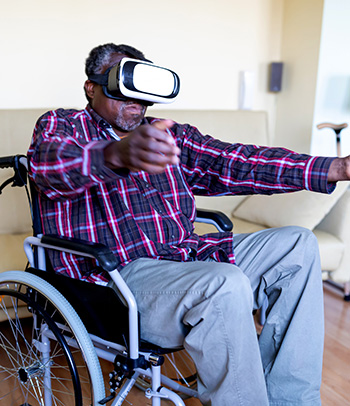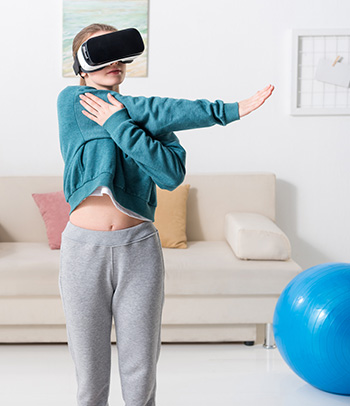VA works to provide high-quality health care to our nation’s Veterans – which means being at the forefront of new and innovative technologies like the use of virtual and augmented reality in health care.
You may have experience with virtual reality or augmented reality already. Maybe you’ve played a video game where you’re immersed in a virtual world totally different from your own, or maybe you’ve used a filter for your photos on social media. If so, you’ve used virtual and augmented reality. But did you know that these technologies can be used to provide health care as well?
The Department of Veterans Affairs (VA) works to provide high-quality health care to our nation’s Veterans – which means being at the forefront of new and innovative technologies like the use of virtual and augmented reality in health care.
Learn more about these technologies and how VA is using them to help Veterans receive the world-class health care they deserve.
What Is Virtual or Augmented Reality?
As mentioned above, you probably have some experience with these technologies already. For example, you may use virtual reality to play video games or maybe you used it during your military training to simulate combat or flight. You may use augmented reality on social media to add filters and special effects to your photos or maybe you’ve used it to try out virtual furniture in your home with a home design app.
Virtual and augmented reality are both part of a larger group of immersive technologies known by VA as “extended reality” or XR. But how are they defined?
Virtual reality produces a totally computer-generated environment with scenes and objects that appear real, making users feel completely immersed in their surroundings. Virtual reality may include sights, sounds, smells and the ability to touch. The digital simulation of a real environment is perceived through a device, typically a virtual reality headset, helmet, goggles or gloves.
Augmented reality is a less immersive form of a virtual experience where users still operate in the real world but with a virtual overlay. Augmented reality makes use of computer-generated imagery that is overlayed on physical elements in the real world, typically through a phone’s camera or video viewer.
Research from the National Institutes of Health (NIH) helps to explain current uses for virtual and augmented reality that you may be familiar with in fields such as exercise, meditation, gaming, education, health care and more.
How Are These Technologies Being Used to Help Veterans?
VA is seen as a leader in the use of immersive technology – researching, testing and incorporating these new technologies to improve the health care of Veterans across the country. According to VA News, VA has deployed more than 2,200 virtual reality headsets across more than 154 VA medical centers and 18 additional sites of care in all 50 states, Guam, American Samoa and Puerto Rico.
These immersive technologies, like virtual reality and augmented reality, are being used to supplement traditional VA health care in numerous ways, including to treat the following health issues: 
- Sleep conditions such as insomnia, exhaustion and sleep apnea
- Phantom limb pain
- Post-traumatic stress disorder (PTSD)
- Phobias
- Stress reduction
- Acute and chronic pain
- Social isolation
- Physical rehabilitation
- Substance use
- Suicide prevention
- Occupational therapy
Here are some examples of what this might actually look like in a health care setting.
An occupational therapist may use virtual reality as a way to help patients build and practice skills they’re struggling with, such as grabbing groceries off a high shelf, carrying a large object and more.
A mental health provider may incorporate virtual reality as part of a treatment plan for PTSD. Virtual reality allows patients to confront and manage their traumas in a safe and controlled environment with a therapist there to help them work through it. By immersing and exposing patients to realistic scenarios an infinite number of times, virtual reality can help desensitize them to their triggers.
A Veteran who is having difficulty sleeping may use a virtual reality headset to immerse themselves in a relaxing meditation before bed.
This VA News story shares more details about how immersive technologies are used by VA staff to help Veterans in diverse ways.
These technologies aren’t designed to replace traditional forms of health care, such as therapy, medication and more, but instead, VA is trying to meet needs that otherwise aren’t being met, to increase access to health care, and to uncover new ways to fill in the gaps of traditional health care.
Where Can I Get More Information?
- VA’s podcast “New Horizons in Health: Bringing Veteran Health Care Into the Future” explains how immersive technologies are being used in Veteran health care. Hear from Paula, a Veteran who uses virtual reality to help her manage her sleep apnea and nighttime anxiety. Listen to Dean, a Veteran who uses virtual reality exercises to reduce his phantom limb pain and help him sleep.
- VA Immersive’s website shares up-to-date information on how virtual reality and augmented reality are being used by VA, including a timeline of their use, videos showing their use in real-life examples and much more.
If you’re interested in learning more about immersive technologies after exploring the information in this article, talk to your VA health care provider and discuss ways that virtual and augmented reality may complement your current health care treatments.







